FIAT FULLBACK 2018 Owner handbook (in English)
Manufacturer: FIAT, Model Year: 2018, Model line: FULLBACK, Model: FIAT FULLBACK 2018Pages: 316, PDF Size: 10.52 MB
Page 131 of 316
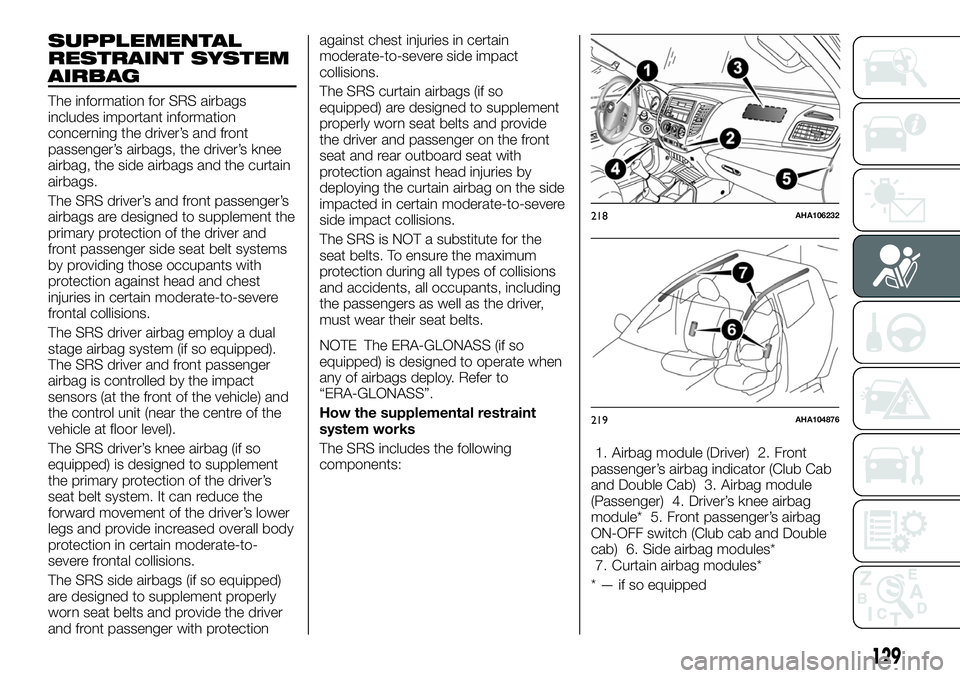
SUPPLEMENTAL
RESTRAINT SYSTEM
AIRBAG
The information for SRS airbags
includes important information
concerning the driver’s and front
passenger’s airbags, the driver’s knee
airbag, the side airbags and the curtain
airbags.
The SRS driver’s and front passenger’s
airbags are designed to supplement the
primary protection of the driver and
front passenger side seat belt systems
by providing those occupants with
protection against head and chest
injuries in certain moderate-to-severe
frontal collisions.
The SRS driver airbag employ a dual
stage airbag system (if so equipped).
The SRS driver and front passenger
airbag is controlled by the impact
sensors (at the front of the vehicle) and
the control unit (near the centre of the
vehicle at floor level).
The SRS driver’s knee airbag (if so
equipped) is designed to supplement
the primary protection of the driver’s
seat belt system. It can reduce the
forward movement of the driver’s lower
legs and provide increased overall body
protection in certain moderate-to-
severe frontal collisions.
The SRS side airbags (if so equipped)
are designed to supplement properly
worn seat belts and provide the driver
and front passenger with protectionagainst chest injuries in certain
moderate-to-severe side impact
collisions.
The SRS curtain airbags (if so
equipped) are designed to supplement
properly worn seat belts and provide
the driver and passenger on the front
seat and rear outboard seat with
protection against head injuries by
deploying the curtain airbag on the side
impacted in certain moderate-to-severe
side impact collisions.
The SRS is NOT a substitute for the
seat belts. To ensure the maximum
protection during all types of collisions
and accidents, all occupants, including
the passengers as well as the driver,
must wear their seat belts.
NOTE The ERA-GLONASS (if so
equipped) is designed to operate when
any of airbags deploy. Refer to
“ERA-GLONASS”.
How the supplemental restraint
system works
The SRS includes the following
components:1. Airbag module (Driver) 2. Front
passenger’s airbag indicator (Club Cab
and Double Cab) 3. Airbag module
(Passenger) 4. Driver’s knee airbag
module* 5. Front passenger’s airbag
ON-OFF switch (Club cab and Double
cab) 6. Side airbag modules*
7. Curtain airbag modules*
* — if so equipped
218AHA106232
219AHA104876
129
Page 132 of 316
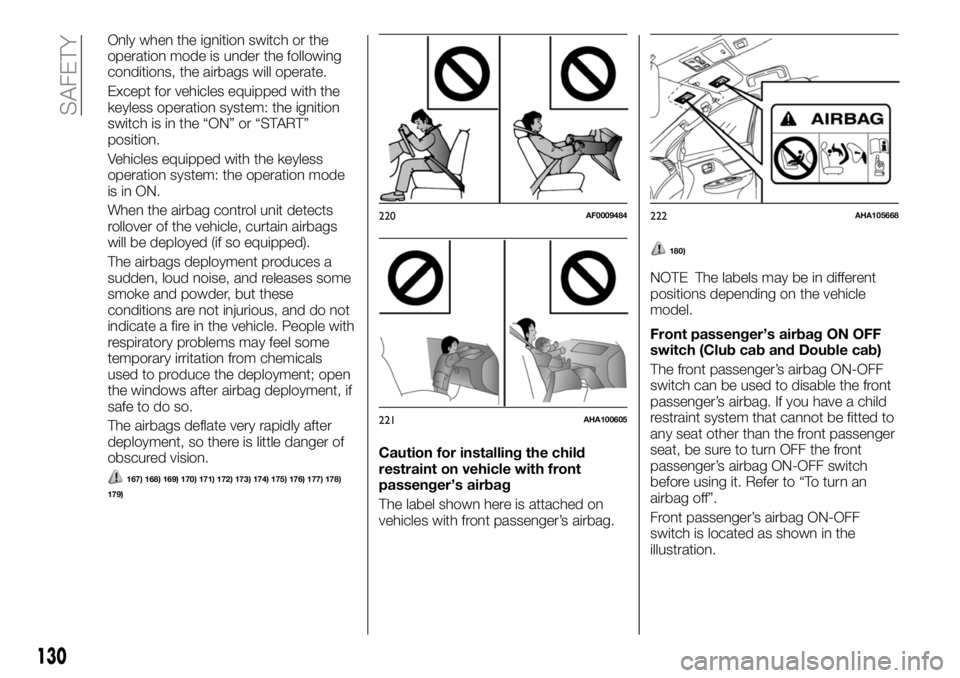
Only when the ignition switch or the
operation mode is under the following
conditions, the airbags will operate.
Except for vehicles equipped with the
keyless operation system: the ignition
switch is in the “ON” or “START”
position.
Vehicles equipped with the keyless
operation system: the operation mode
is in ON.
When the airbag control unit detects
rollover of the vehicle, curtain airbags
will be deployed (if so equipped).
The airbags deployment produces a
sudden, loud noise, and releases some
smoke and powder, but these
conditions are not injurious, and do not
indicate a fire in the vehicle. People with
respiratory problems may feel some
temporary irritation from chemicals
used to produce the deployment; open
the windows after airbag deployment, if
safe to do so.
The airbags deflate very rapidly after
deployment, so there is little danger of
obscured vision.
167) 168) 169) 170) 171) 172) 173) 174) 175) 176) 177) 178)
179)
Caution for installing the child
restraint on vehicle with front
passenger’s airbag
The label shown here is attached on
vehicles with front passenger’s airbag.
180)
NOTE The labels may be in different
positions depending on the vehicle
model.
Front passenger’s airbag ON OFF
switch (Club cab and Double cab)
The front passenger’s airbag ON-OFF
switch can be used to disable the front
passenger’s airbag. If you have a child
restraint system that cannot be fitted to
any seat other than the front passenger
seat, be sure to turn OFF the front
passenger’s airbag ON-OFF switch
before using it. Refer to “To turn an
airbag off”.
Front passenger’s airbag ON-OFF
switch is located as shown in the
illustration.
220AF0009484
221AHA100605
222AHA105668
130
SAFETY
Page 133 of 316
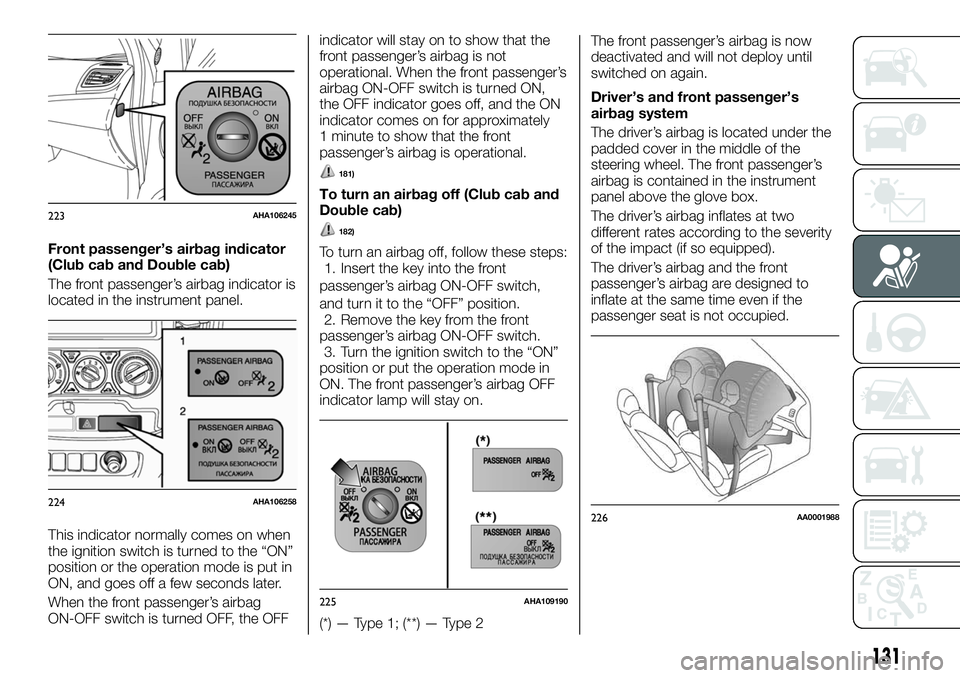
Front passenger’s airbag indicator
(Club cab and Double cab)
The front passenger’s airbag indicator is
located in the instrument panel.
This indicator normally comes on when
the ignition switch is turned to the “ON”
position or the operation mode is put in
ON, and goes off a few seconds later.
When the front passenger’s airbag
ON-OFF switch is turned OFF, the OFFindicator will stay on to show that the
front passenger’s airbag is not
operational. When the front passenger’s
airbag ON-OFF switch is turned ON,
the OFF indicator goes off, and the ON
indicator comes on for approximately
1 minute to show that the front
passenger’s airbag is operational.
181)
To turn an airbag off (Club cab and
Double cab)
182)
To turn an airbag off, follow these steps:
1. Insert the key into the front
passenger’s airbag ON-OFF switch,
and turn it to the “OFF” position.
2. Remove the key from the front
passenger’s airbag ON-OFF switch.
3. Turn the ignition switch to the “ON”
position or put the operation mode in
ON. The front passenger’s airbag OFF
indicator lamp will stay on.
(*) — Type 1; (**) — Type 2The front passenger’s airbag is now
deactivated and will not deploy until
switched on again.
Driver’s and front passenger’s
airbag system
The driver’s airbag is located under the
padded cover in the middle of the
steering wheel. The front passenger’s
airbag is contained in the instrument
panel above the glove box.
The driver’s airbag inflates at two
different rates according to the severity
of the impact (if so equipped).
The driver’s airbag and the front
passenger’s airbag are designed to
inflate at the same time even if the
passenger seat is not occupied.
223AHA106245
224AHA106258
225AHA109190
226AA0001988
131
Page 134 of 316
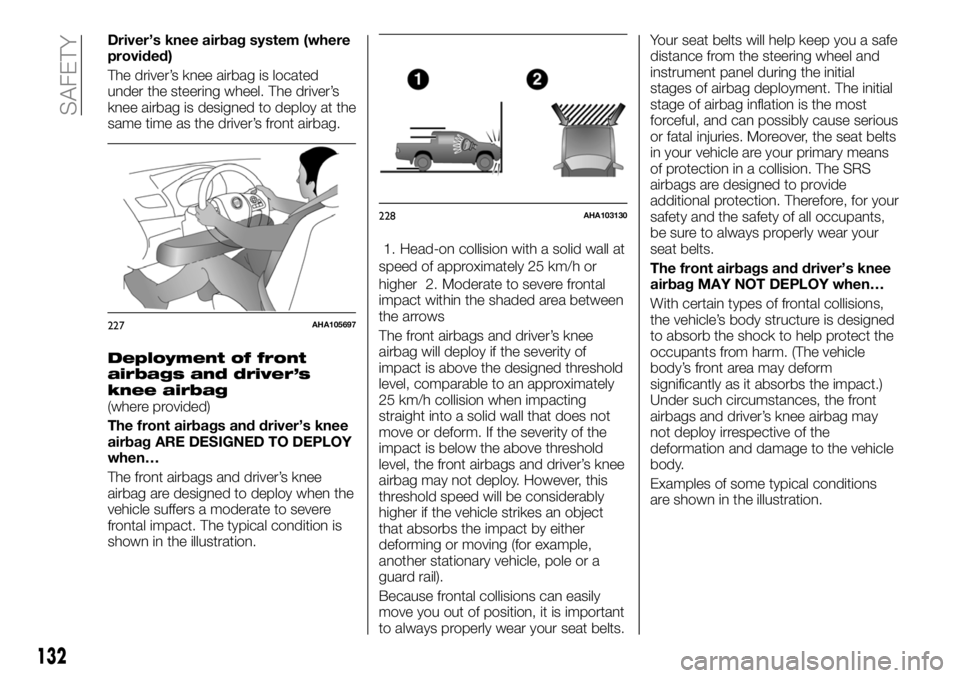
Driver’s knee airbag system (where
provided)
The driver’s knee airbag is located
under the steering wheel. The driver’s
knee airbag is designed to deploy at the
same time as the driver’s front airbag.
Deployment of front
airbags and driver’s
knee airbag
(where provided)
The front airbags and driver’s knee
airbag ARE DESIGNED TO DEPLOY
when…
The front airbags and driver’s knee
airbag are designed to deploy when the
vehicle suffers a moderate to severe
frontal impact. The typical condition is
shown in the illustration.1. Head-on collision with a solid wall at
speed of approximately 25 km/h or
higher 2. Moderate to severe frontal
impact within the shaded area between
the arrows
The front airbags and driver’s knee
airbag will deploy if the severity of
impact is above the designed threshold
level, comparable to an approximately
25 km/h collision when impacting
straight into a solid wall that does not
move or deform. If the severity of the
impact is below the above threshold
level, the front airbags and driver’s knee
airbag may not deploy. However, this
threshold speed will be considerably
higher if the vehicle strikes an object
that absorbs the impact by either
deforming or moving (for example,
another stationary vehicle, pole or a
guard rail).
Because frontal collisions can easily
move you out of position, it is important
to always properly wear your seat belts.Your seat belts will help keep you a safe
distance from the steering wheel and
instrument panel during the initial
stages of airbag deployment. The initial
stage of airbag inflation is the most
forceful, and can possibly cause serious
or fatal injuries. Moreover, the seat belts
in your vehicle are your primary means
of protection in a collision. The SRS
airbags are designed to provide
additional protection. Therefore, for your
safety and the safety of all occupants,
be sure to always properly wear your
seat belts.
The front airbags and driver’s knee
airbag MAY NOT DEPLOY when…
With certain types of frontal collisions,
the vehicle’s body structure is designed
to absorb the shock to help protect the
occupants from harm. (The vehicle
body’s front area may deform
significantly as it absorbs the impact.)
Under such circumstances, the front
airbags and driver’s knee airbag may
not deploy irrespective of the
deformation and damage to the vehicle
body.
Examples of some typical conditions
are shown in the illustration.
227AHA105697
228AHA103130
132
SAFETY
Page 135 of 316
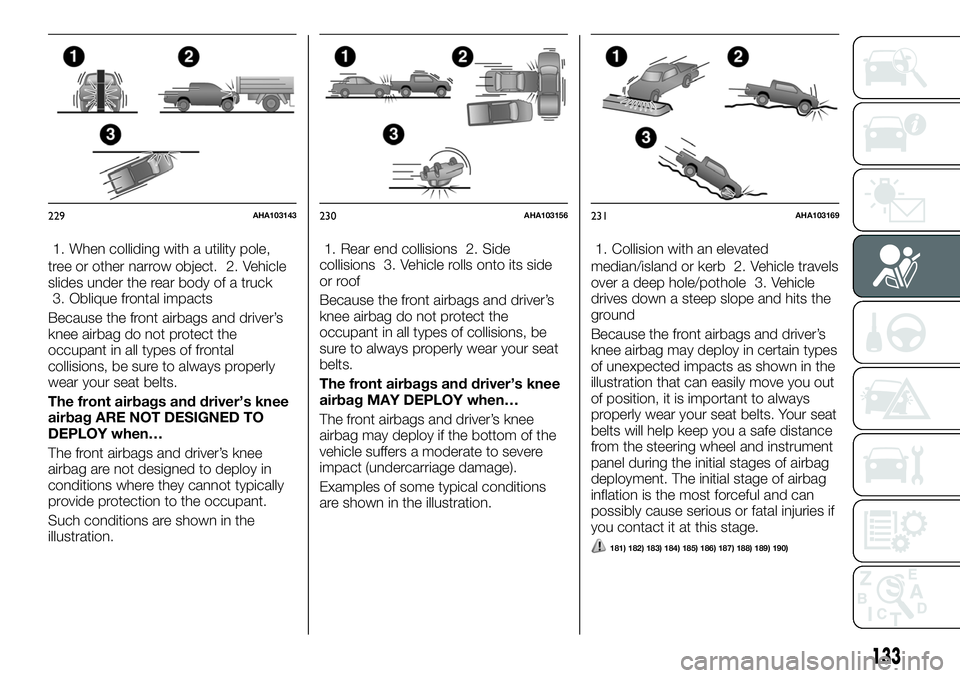
1. When colliding with a utility pole,
tree or other narrow object. 2. Vehicle
slides under the rear body of a truck
3. Oblique frontal impacts
Because the front airbags and driver’s
knee airbag do not protect the
occupant in all types of frontal
collisions, be sure to always properly
wear your seat belts.
The front airbags and driver’s knee
airbag ARE NOT DESIGNED TO
DEPLOY when…
The front airbags and driver’s knee
airbag are not designed to deploy in
conditions where they cannot typically
provide protection to the occupant.
Such conditions are shown in the
illustration.1. Rear end collisions 2. Side
collisions 3. Vehicle rolls onto its side
or roof
Because the front airbags and driver’s
knee airbag do not protect the
occupant in all types of collisions, be
sure to always properly wear your seat
belts.
The front airbags and driver’s knee
airbag MAY DEPLOY when…
The front airbags and driver’s knee
airbag may deploy if the bottom of the
vehicle suffers a moderate to severe
impact (undercarriage damage).
Examples of some typical conditions
are shown in the illustration.1. Collision with an elevated
median/island or kerb 2. Vehicle travels
over a deep hole/pothole 3. Vehicle
drives down a steep slope and hits the
ground
Because the front airbags and driver’s
knee airbag may deploy in certain types
of unexpected impacts as shown in the
illustration that can easily move you out
of position, it is important to always
properly wear your seat belts. Your seat
belts will help keep you a safe distance
from the steering wheel and instrument
panel during the initial stages of airbag
deployment. The initial stage of airbag
inflation is the most forceful and can
possibly cause serious or fatal injuries if
you contact it at this stage.
181) 182) 183) 184) 185) 186) 187) 188) 189) 190)
229AHA103143230AHA103156231AHA103169
133
Page 136 of 316
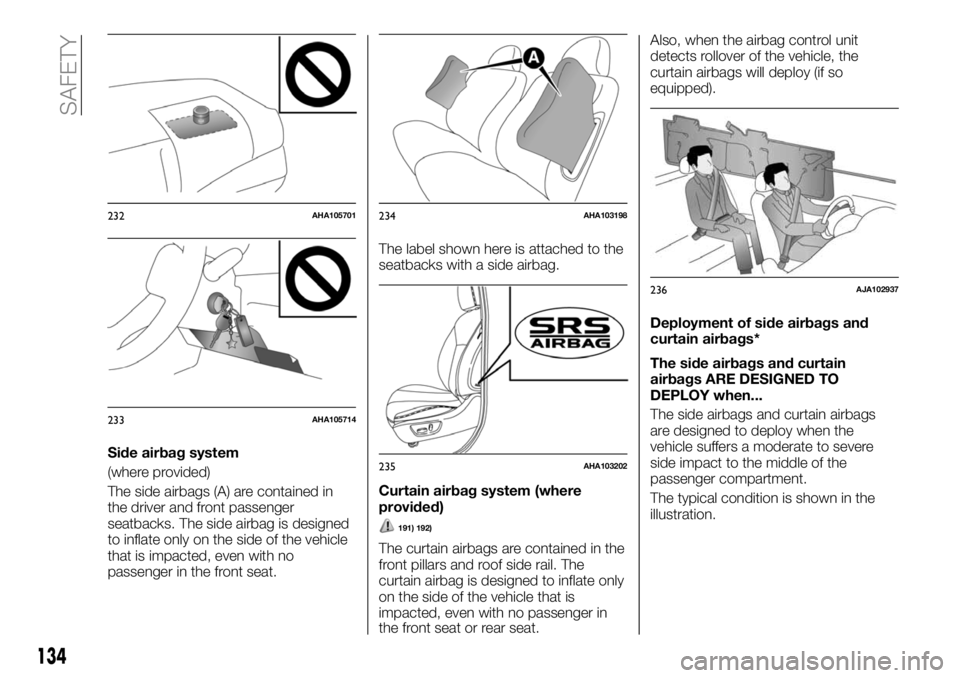
Side airbag system
(where provided)
The side airbags (A) are contained in
the driver and front passenger
seatbacks. The side airbag is designed
to inflate only on the side of the vehicle
that is impacted, even with no
passenger in the front seat.The label shown here is attached to the
seatbacks with a side airbag.
Curtain airbag system (where
provided)
191) 192)
The curtain airbags are contained in the
front pillars and roof side rail. The
curtain airbag is designed to inflate only
on the side of the vehicle that is
impacted, even with no passenger in
the front seat or rear seat.Also, when the airbag control unit
detects rollover of the vehicle, the
curtain airbags will deploy (if so
equipped).
Deployment of side airbags and
curtain airbags*
The side airbags and curtain
airbags ARE DESIGNED TO
DEPLOY when...
The side airbags and curtain airbags
are designed to deploy when the
vehicle suffers a moderate to severe
side impact to the middle of the
passenger compartment.
The typical condition is shown in the
illustration.
232AHA105701
233AHA105714
234AHA103198
235AHA103202
236AJA102937
134
SAFETY
Page 137 of 316
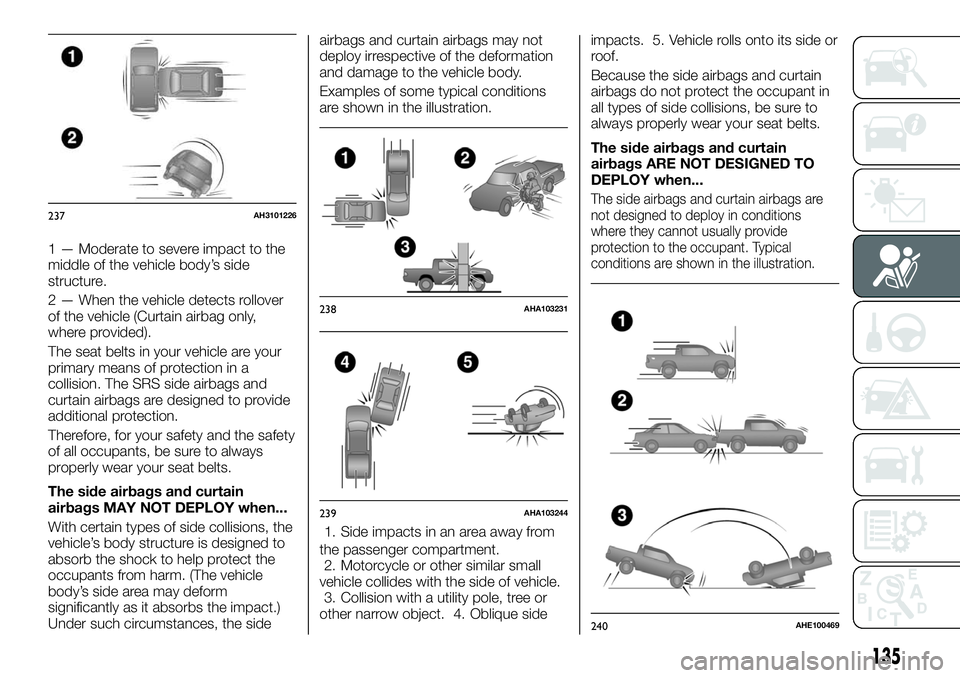
1 — Moderate to severe impact to the
middle of the vehicle body’s side
structure.
2 — When the vehicle detects rollover
of the vehicle (Curtain airbag only,
where provided).
The seat belts in your vehicle are your
primary means of protection in a
collision. The SRS side airbags and
curtain airbags are designed to provide
additional protection.
Therefore, for your safety and the safety
of all occupants, be sure to always
properly wear your seat belts.
The side airbags and curtain
airbags MAY NOT DEPLOY when...
With certain types of side collisions, the
vehicle’s body structure is designed to
absorb the shock to help protect the
occupants from harm. (The vehicle
body’s side area may deform
significantly as it absorbs the impact.)
Under such circumstances, the sideairbags and curtain airbags may not
deploy irrespective of the deformation
and damage to the vehicle body.
Examples of some typical conditions
are shown in the illustration.
1. Side impacts in an area away from
the passenger compartment.
2. Motorcycle or other similar small
vehicle collides with the side of vehicle.
3. Collision with a utility pole, tree or
other narrow object. 4. Oblique sideimpacts. 5. Vehicle rolls onto its side or
roof.
Because the side airbags and curtain
airbags do not protect the occupant in
all types of side collisions, be sure to
always properly wear your seat belts.
The side airbags and curtain
airbags ARE NOT DESIGNED TO
DEPLOY when...
The side airbags and curtain airbags are
not designed to deploy in conditions
where they cannot usually provide
protection to the occupant. Typical
conditions are shown in the illustration.237AH3101226
238AHA103231
239AHA103244
240AHE100469
135
Page 138 of 316
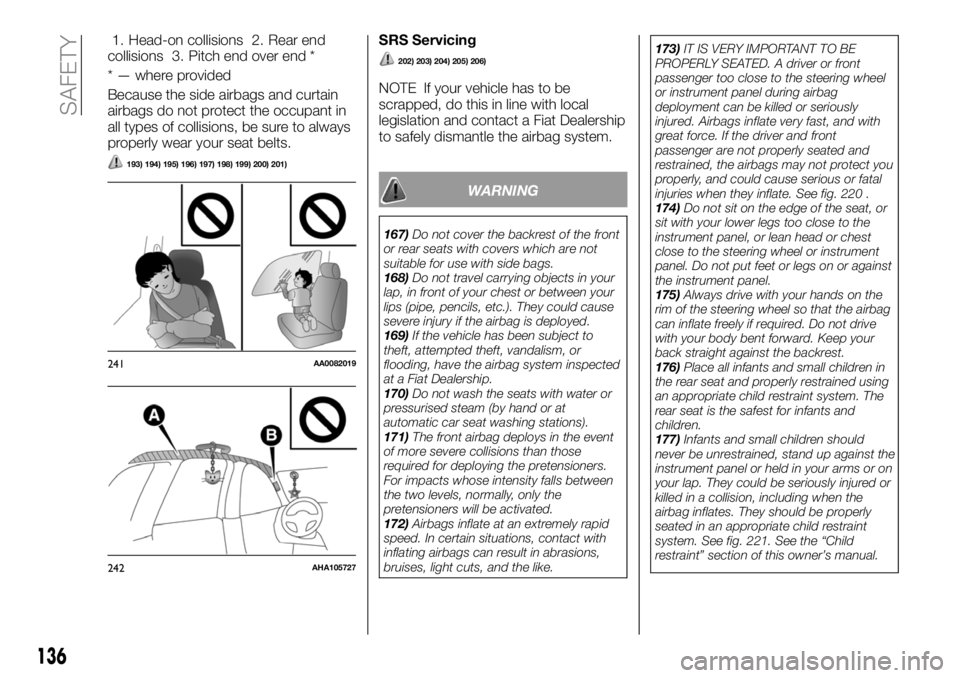
1. Head-on collisions 2. Rear end
collisions 3. Pitch end over end *
* — where provided
Because the side airbags and curtain
airbags do not protect the occupant in
all types of collisions, be sure to always
properly wear your seat belts.
193) 194) 195) 196) 197) 198) 199) 200) 201)
SRS Servicing
202) 203) 204) 205) 206)
NOTE If your vehicle has to be
scrapped, do this in line with local
legislation and contact a Fiat Dealership
to safely dismantle the airbag system.
WARNING
167)Do not cover the backrest of the front
or rear seats with covers which are not
suitable for use with side bags.
168)Do not travel carrying objects in your
lap, in front of your chest or between your
lips (pipe, pencils, etc.). They could cause
severe injury if the airbag is deployed.
169)If the vehicle has been subject to
theft, attempted theft, vandalism, or
flooding, have the airbag system inspected
at a Fiat Dealership.
170)Do not wash the seats with water or
pressurised steam (by hand or at
automatic car seat washing stations).
171)The front airbag deploys in the event
of more severe collisions than those
required for deploying the pretensioners.
For impacts whose intensity falls between
the two levels, normally, only the
pretensioners will be activated.
172)Airbags inflate at an extremely rapid
speed. In certain situations, contact with
inflating airbags can result in abrasions,
bruises, light cuts, and the like.173)IT IS VERY IMPORTANT TO BE
PROPERLY SEATED. A driver or front
passenger too close to the steering wheel
or instrument panel during airbag
deployment can be killed or seriously
injured. Airbags inflate very fast, and with
great force. If the driver and front
passenger are not properly seated and
restrained, the airbags may not protect you
properly, and could cause serious or fatal
injuries when they inflate. See fig. 220 .
174)Do not sit on the edge of the seat, or
sit with your lower legs too close to the
instrument panel, or lean head or chest
close to the steering wheel or instrument
panel. Do not put feet or legs on or against
the instrument panel.
175)Always drive with your hands on the
rim of the steering wheel so that the airbag
can inflate freely if required. Do not drive
with your body bent forward. Keep your
back straight against the backrest.
176)Place all infants and small children in
the rear seat and properly restrained using
an appropriate child restraint system. The
rear seat is the safest for infants and
children.
177)Infants and small children should
never be unrestrained, stand up against the
instrument panel or held in your arms or on
your lap. They could be seriously injured or
killed in a collision, including when the
airbag inflates. They should be properly
seated in an appropriate child restraint
system. See fig. 221. See the “Child
restraint” section of this owner’s manual.
241AA0082019
242AHA105727
136
SAFETY
Page 139 of 316
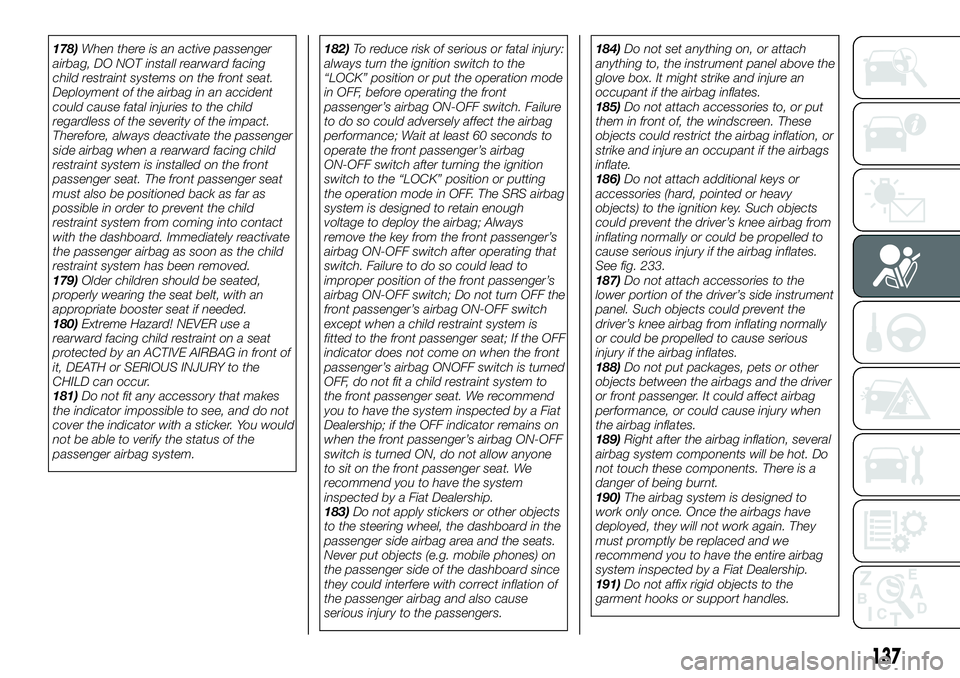
178)When there is an active passenger
airbag, DO NOT install rearward facing
child restraint systems on the front seat.
Deployment of the airbag in an accident
could cause fatal injuries to the child
regardless of the severity of the impact.
Therefore, always deactivate the passenger
side airbag when a rearward facing child
restraint system is installed on the front
passenger seat. The front passenger seat
must also be positioned back as far as
possible in order to prevent the child
restraint system from coming into contact
with the dashboard. Immediately reactivate
the passenger airbag as soon as the child
restraint system has been removed.
179)Older children should be seated,
properly wearing the seat belt, with an
appropriate booster seat if needed.
180)Extreme Hazard! NEVER use a
rearward facing child restraint on a seat
protected by an ACTIVE AIRBAG in front of
it, DEATH or SERIOUS INJURY to the
CHILD can occur.
181)Do not fit any accessory that makes
the indicator impossible to see, and do not
cover the indicator with a sticker. You would
not be able to verify the status of the
passenger airbag system.182)To reduce risk of serious or fatal injury:
always turn the ignition switch to the
“LOCK” position or put the operation mode
in OFF, before operating the front
passenger’s airbag ON-OFF switch. Failure
to do so could adversely affect the airbag
performance; Wait at least 60 seconds to
operate the front passenger’s airbag
ON-OFF switch after turning the ignition
switch to the “LOCK” position or putting
the operation mode in OFF. The SRS airbag
system is designed to retain enough
voltage to deploy the airbag; Always
remove the key from the front passenger’s
airbag ON-OFF switch after operating that
switch. Failure to do so could lead to
improper position of the front passenger’s
airbag ON-OFF switch; Do not turn OFF the
front passenger’s airbag ON-OFF switch
except when a child restraint system is
fitted to the front passenger seat; If the OFF
indicator does not come on when the front
passenger’s airbag ONOFF switch is turned
OFF, do not fit a child restraint system to
the front passenger seat. We recommend
you to have the system inspected by a Fiat
Dealership; if the OFF indicator remains on
when the front passenger’s airbag ON-OFF
switch is turned ON, do not allow anyone
to sit on the front passenger seat. We
recommend you to have the system
inspected by a Fiat Dealership.
183)Do not apply stickers or other objects
to the steering wheel, the dashboard in the
passenger side airbag area and the seats.
Never put objects (e.g. mobile phones) on
the passenger side of the dashboard since
they could interfere with correct inflation of
the passenger airbag and also cause
serious injury to the passengers.184)Do not set anything on, or attach
anything to, the instrument panel above the
glove box. It might strike and injure an
occupant if the airbag inflates.
185)Do not attach accessories to, or put
them in front of, the windscreen. These
objects could restrict the airbag inflation, or
strike and injure an occupant if the airbags
inflate.
186)Do not attach additional keys or
accessories (hard, pointed or heavy
objects) to the ignition key. Such objects
could prevent the driver’s knee airbag from
inflating normally or could be propelled to
cause serious injury if the airbag inflates.
See fig. 233.
187)Do not attach accessories to the
lower portion of the driver’s side instrument
panel. Such objects could prevent the
driver’s knee airbag from inflating normally
or could be propelled to cause serious
injury if the airbag inflates.
188)Do not put packages, pets or other
objects between the airbags and the driver
or front passenger. It could affect airbag
performance, or could cause injury when
the airbag inflates.
189)Right after the airbag inflation, several
airbag system components will be hot. Do
not touch these components. There is a
danger of being burnt.
190)The airbag system is designed to
work only once. Once the airbags have
deployed, they will not work again. They
must promptly be replaced and we
recommend you to have the entire airbag
system inspected by a Fiat Dealership.
191)Do not affix rigid objects to the
garment hooks or support handles.
137
Page 140 of 316
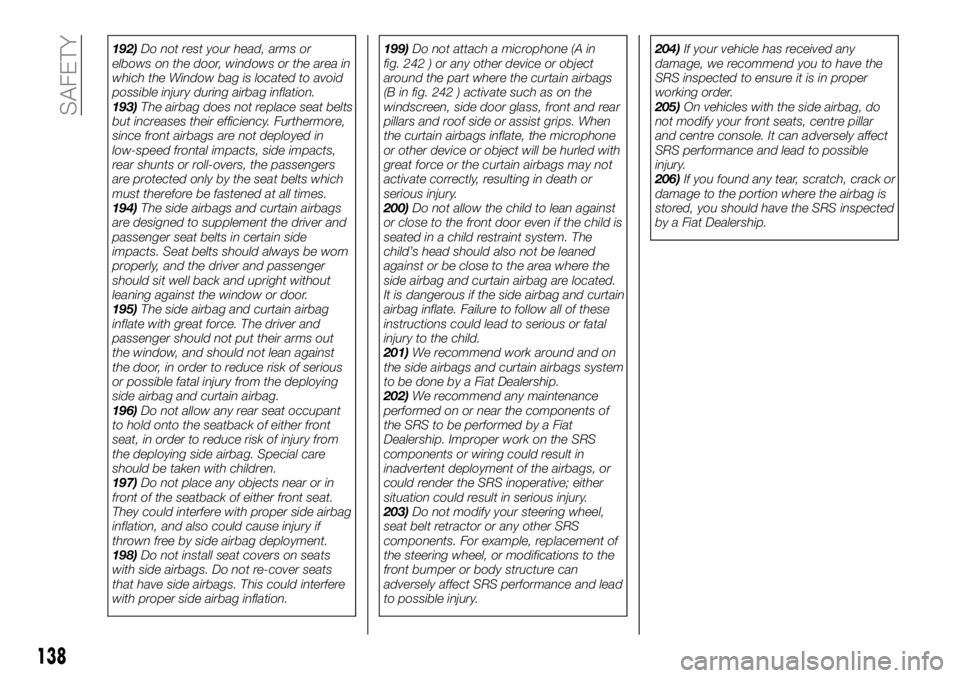
192)Do not rest your head, arms or
elbows on the door, windows or the area in
which the Window bag is located to avoid
possible injury during airbag inflation.
193)The airbag does not replace seat belts
but increases their efficiency. Furthermore,
since front airbags are not deployed in
low-speed frontal impacts, side impacts,
rear shunts or roll-overs, the passengers
are protected only by the seat belts which
must therefore be fastened at all times.
194)The side airbags and curtain airbags
are designed to supplement the driver and
passenger seat belts in certain side
impacts. Seat belts should always be worn
properly, and the driver and passenger
should sit well back and upright without
leaning against the window or door.
195)The side airbag and curtain airbag
inflate with great force. The driver and
passenger should not put their arms out
the window, and should not lean against
the door, in order to reduce risk of serious
or possible fatal injury from the deploying
side airbag and curtain airbag.
196)Do not allow any rear seat occupant
to hold onto the seatback of either front
seat, in order to reduce risk of injury from
the deploying side airbag. Special care
should be taken with children.
197)Do not place any objects near or in
front of the seatback of either front seat.
They could interfere with proper side airbag
inflation, and also could cause injury if
thrown free by side airbag deployment.
198)Do not install seat covers on seats
with side airbags. Do not re-cover seats
that have side airbags. This could interfere
with proper side airbag inflation.199)Do not attach a microphone (A in
fig. 242 ) or any other device or object
around the part where the curtain airbags
(B in fig. 242 ) activate such as on the
windscreen, side door glass, front and rear
pillars and roof side or assist grips. When
the curtain airbags inflate, the microphone
or other device or object will be hurled with
great force or the curtain airbags may not
activate correctly, resulting in death or
serious injury.
200)Do not allow the child to lean against
or close to the front door even if the child is
seated in a child restraint system. The
child’s head should also not be leaned
against or be close to the area where the
side airbag and curtain airbag are located.
It is dangerous if the side airbag and curtain
airbag inflate. Failure to follow all of these
instructions could lead to serious or fatal
injury to the child.
201)We recommend work around and on
the side airbags and curtain airbags system
to be done by a Fiat Dealership.
202)We recommend any maintenance
performed on or near the components of
the SRS to be performed by a Fiat
Dealership. Improper work on the SRS
components or wiring could result in
inadvertent deployment of the airbags, or
could render the SRS inoperative; either
situation could result in serious injury.
203)Do not modify your steering wheel,
seat belt retractor or any other SRS
components. For example, replacement of
the steering wheel, or modifications to the
front bumper or body structure can
adversely affect SRS performance and lead
to possible injury.204)If your vehicle has received any
damage, we recommend you to have the
SRS inspected to ensure it is in proper
working order.
205)On vehicles with the side airbag, do
not modify your front seats, centre pillar
and centre console. It can adversely affect
SRS performance and lead to possible
injury.
206)If you found any tear, scratch, crack or
damage to the portion where the airbag is
stored, you should have the SRS inspected
by a Fiat Dealership.
138
SAFETY